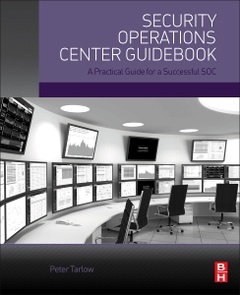Description
Security Operations Center Guidebook
A Practical Guide for a Successful SOC
Authors: Jarpey Gregory, McCoy Scott
Language: English
Subjects for Security Operations Center Guidebook:
Keywords
Access card; Access control; Access control system; Access control system (ACS); Access points; Alarm monitoring; Alarm signals; Authorized personnel; Backup generators; Black Belt; Body opponent bag; Brand awareness; Budget challenge; Business case; Camera footage; Capital dollars; Capital investment; Card access system; Centralization; Chain-of-command; Color coding; Communication; Communications department; Confidentiality; Corporate security; Corporate security department; Cost savings; Counseling session; Credibility; Crisis management; Customer satisfaction; Customer service; Daily activity report; Daily activity reports (DARs); Data center; Deck-to-deck walls; Door forced alarms; Door help open alarms; Downtown operations; Electronic post orders; Finance group; Financing department; Game plan; Handwriting qualities; Hi-temperature alarms; ID badges; Incident report; Incident reporting; Individual training checklist (ITC); Indoctrination program; Intranet website; Intruder; Intrusion alarm; Mag locks; Management; Management personnel; Mechanical alarms; Miscommunication; Monitoring screens; Monitoring video; Mother Ship; Network outages; Notifications; Offsite vendor; Operator's workstation; PSP certification; Personal USB devices; Primary call center; Professional services; Project management; Project manager; Property; Restricted area owner; Return on investment; Risk assessment; SOC; SOC operators; Sales pitch; Security awareness; Security awareness training; Security clearance; Security console operator; Security director; Security equipment; Security industry; Security installations; Security leadership; Security officer; Security personnel; Security violation; Shared services organization; Site procedures; Six Sigma; Staffing model; Standard equipment; Strategic partnerships; Subcontractors; Teleconferencing; Third party; Training
98.24 €
In Print (Delivery period: 14 days).
Add to cartSupport: Print on demand
Description
/li>Contents
/li>Biography
/li>Comment
/li>
Security Operations Center Guidebook: A Practical Guide for a Successful SOC provides everything security professionals need to create and operate a world-class Security Operations Center. It starts by helping professionals build a successful business case using financial, operational, and regulatory requirements to support the creation and operation of an SOC. It then delves into the policies and procedures necessary to run an effective SOC and explains how to gather the necessary metrics to persuade upper management that a company?s SOC is providing value.
This comprehensive text also covers more advanced topics, such as the most common Underwriter Laboratory (UL) listings that can be acquired, how and why they can help a company, and what additional activities and services an SOC can provide to maximize value to a company.
Part I – Developing Your Security Operations Center1. What is a Security Operations Center?2. Needs Assessment3. Business Case4. Building Your SOC5. Staffing Options
Part II – Operations 6. Responsibilities and Duties7. Post Orders and Procedures8. Training Programs9. Enterprise Access Control10. Alarm Monitoring11. Enterprise Video Surveillance12. Working with Your Vendors13. Incident Reporting14. Communication Plan 15. The Emergency Operations Center
Part III – Making the SOC an integral part of your Company16. Customer Service is KEY17. Metrics18. Developing Partnerships19. Brand Recognition20. Continuous Improvement
Scott McCoy has more than 30 years of risk management experience starting in the U.S. Army as an explosive ordnance disposal technician. Scott has spent nearly 20 years in corporate security management and received his CPP (Certified Protection Professional certification) from ASIS in 2002. He also received his Certified Information Systems Security Professional (CISSP) and Certified Business Continuity Professional (CBCP) certifications in order to better understand the disciplines of a converged security department, which he formed at Xcel Energy and Alliant Techsystems. He has a Master’s degree in Management, and has five years’ experience as an adjunct instructor teaching masters level courses in decision making, IT security and security management. He has presented at local and national ASIS conferences on background screening and metrics, and has published magazine articles and white papers on utility specific regulatory issues. In addition, he has contributed several chapters on IT security topics.
- Helps security professionals build a successful business case for a Security Operations Center, including information on the necessary financial, operational, and regulatory requirements
- Includes the required procedures, policies, and metrics to consider
- Addresses the often opposing objectives between the security department and the rest of the business with regard to security investments
- Features objectives, case studies, checklists, and samples where applicable




